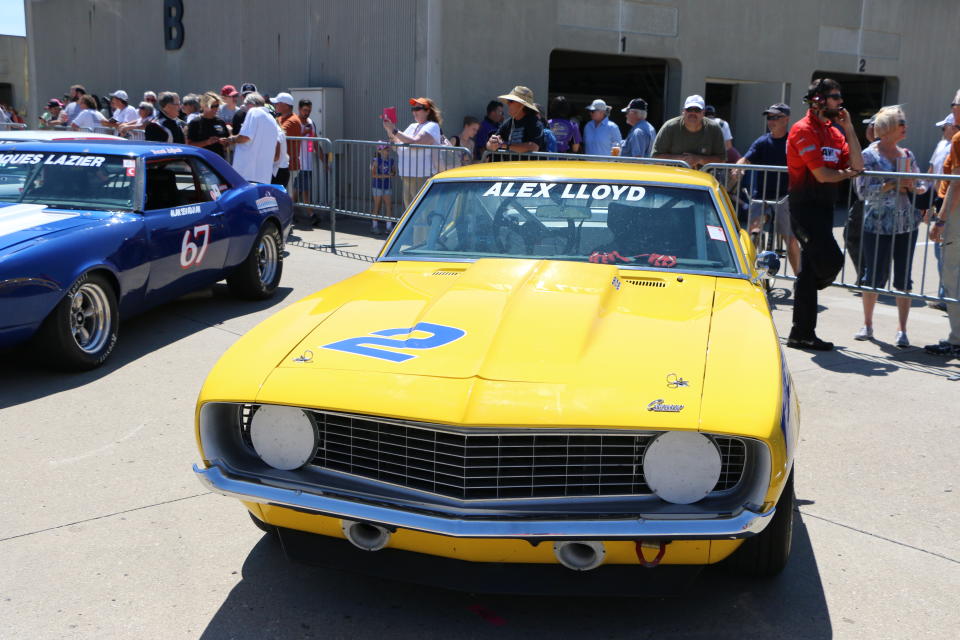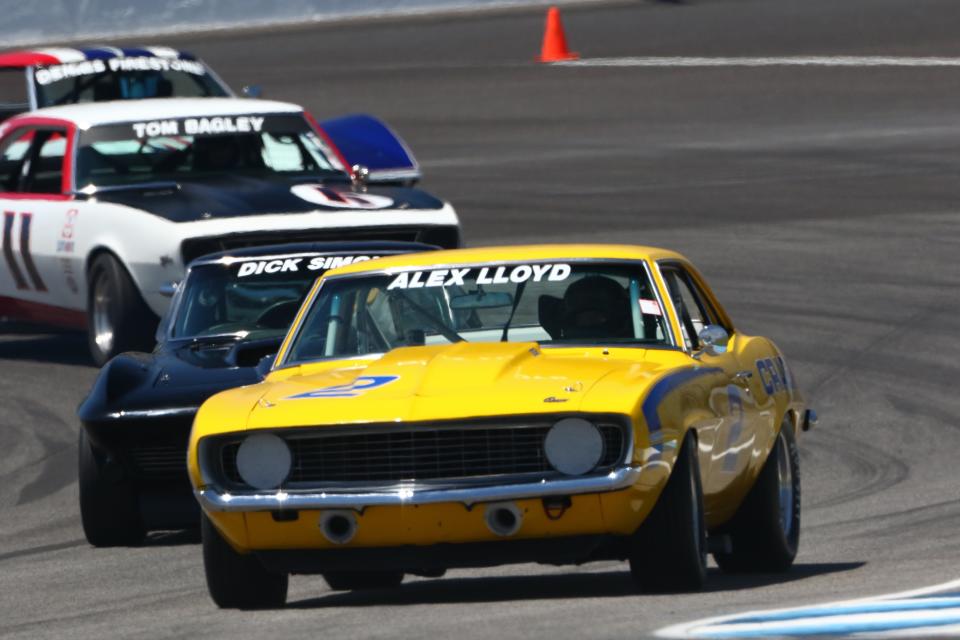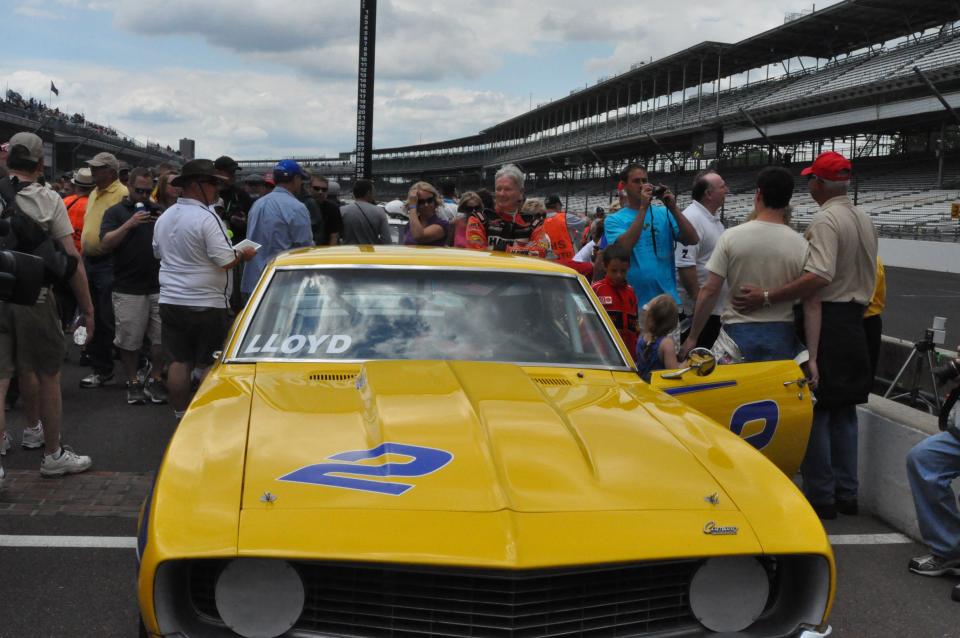A Retired Racer Rediscovers His Identity by Getting Back on Track

More than 10 percent of the living Indianapolis 500 race car drivers-33 of the 287-are squinting on the Speedway's fabled yard of bricks. The sun beats down and cameras flash. Three-time winner Bobby Unser-as has become tradition-wanders up late. The 82-year-old is not racing himself, rather he's supporting family. Al Unser Jr. and Robby Unser smile as Willy T. Ribbs, the first African-American to compete in the 500, makes his annual crack at Bobby's tardiness: "Come on, old man!" he jokes. "We ain't gettin' any younger."
I'm standing behind Dick Simon-a legend who first competed in the 500 back in 1970 and went on to become a decorated team owner. The media's barrage of photos continues. To my left is Paul Tracy, then Lyn St. James, Davy Jones and Roberto Guerrero. The list of fabulous, game-changing racers goes on and on.
The race cars that await are not modern IndyCars, and this isn't the month of May. It is, in fact, June, and the machines on hand are vintage muscle cars, ranging from small block to big block, all from between 1963 and 1972.
This is the 2016 Brickyard Invitational, a gathering of some 500 vintage race cars at the Indianapolis Motor Speedway. It's a trip down memory lane-a place where the smell of burning oil and the often-carbureted soundtrack is as evocative as the sights.
Saturday is the main event, the "Indy Legends Pro/Am." Here, our 33 former Indianapolis 500 drivers (of which I'm one) get to compete on IMS' road course, sharing the car with our respective amateurs. My amateur's name is Dave Roberts, an incredibly successful businessman and a lovely, delightful chap. Our car? A yellow and blue 1969 Chevrolet Camaro. In short, this is one kickass event.

But it's also an emotional one.
That may seem odd. After all, we 'pros' have competed in the most spectacular race in motorsports, and some have even tasted the milk. Yet in this casual race, where for the first time in our lives winning really doesn't matter (it genuinely is about participating), you'll seldom find a group of champions with a brighter glisten in their eye.
Max Papis-an F1, Champ Car, IndyCar, sports car and NASCAR driver-said it best prior to the race: "Sometimes we drivers need reminding of who we once were and the amazing things we did."
Davy Jones followed up by noting that, even after an immensely successful career himself-highlighted by victory in the 1996 24 Hours of Le Mans and a second place finish in the 500 that same year-he still, to this day, struggles watching the Indy 500. In fact, he won't go back to see it in person.
In retirement, a racer loses a piece of themselves. Something that made them who they are.
Why? Because in retirement, a racer loses a piece of themselves. Something that made them who they are. I was reminded of this when listening to Michael Phelps talk about his troubles over the past few years, prior to the Olympic Games in Rio. He talked about how retiring from swimming made him feel as if he'd lost his identity, and without that, he could no longer determine his place in the world. That, of course, led to some dark days, culminating in his second DUI-the catalyst that put him back in the pool and, in turn, the rediscovery of his former self.
For many of the 33, myself included, that same identity crisis is evident. After all, we've spent most of our lives driving race cars. We competed in the most prestigious race in the world, over and over-signed autographs, risked our lives, welcomed the cheers, basked in the bright lights, drank the champagne, and tasted success.
And then nothing. It all just stops.

You forget who you are. You're no longer a racer; you're now a 'former' driver, an afterthought-forgotten. Those memories seem like someone else's. Sure, what you did was remarkable-in history, only 700-some people have ever competed in the 500-but, over time, memories fade. Few drivers will ever admit it, but in the rarest of moments, in the most intimate of settings, you'll hear it shared.
In even rarer moments, you'll get the opportunity to find that identity again. That's what was happening at Indianapolis in June.
The earth shakes as the race begins. Amateurs start, handing the car over to the pro after a few laps. It's not long before I'm in the car. We're in the small block class, our 302 V8 putting out 640 horsepower. I'd driven a BMW M2 the previous week-agile, elegant, precise and engaging. This isn't that. Driving an old muscle car is like wrestling a fat uncle. To make an impact, you've got to dig your elbows in, grab some flesh, and attack violently.
Nevertheless, I wheel that Camaro as hard as I can, as if my life depends on it-until my arms can take no more.
Amid the blubber, it remains a wonderful sensation. The noise, the way the rear tires gracefully slip, the crowd cheering like it's the late '60s and your name is Donohue. Even with 640 horses pushing us forward, we're down on power. Nevertheless, I wheel that Camaro as hard as I can, as if my life depends on it-until my arms can take no more.
As it turns out, the car gives in before my arms. A component on the left rear suspension fails, causing me to limp around at near-walking pace. It sucks, but as they say, that's racing. I'm just thankful to be a part of it again.
Tony Parella, SVRA's president and CEO, is responsible for the race. Tony knew that bringing back veteran drivers, placing them in vintage muscle cars and letting them compete wheel to wheel, would be a thrilling show for fans-and an awesome experience for drivers, many of whom never had the opportunity to share the life they once lived with their children.
But I don't believe Tony realizes the profound affect he's had. For me personally, I'm happy in life, with a successful new career and an amazing family. By all accounts I'm a very lucky guy.
But there is a hole.
And while I can't talk for every 'former' driver, I'd wager most feel a similar way. We miss it. We miss that person we used to be-just like Phelps said. What hurts the most is that my children will never truly understand the career I once had. To them, "daddy was a champion racer" is a story, something that sounds cool but is not really real. I suppose that's now how it feels to me too.
What Tony does is help us remember. He's not simply bringing back a bunch of veterans to help sell tickets, he's filling a void; in a way, delivering us our life back-our identity. He's letting our children see us in action, in anger, the way we once were.

If just for one weekend in June.
@Alex_Lloyd is Head of Content at Beepi, a radically transparent and easy way to buy, sell and lease cars online. Much of his professional life has been spent driving race cars-competing in the Indianapolis 500 numerous times, finishing fourth in 2010. When he's not racing, and not working, he'll typically be found hanging out with his wife and four young children. Rumor has it he plans to start his own basketball team, consisting only of his own offspring.
You Might Also Like

 Yahoo Autos
Yahoo Autos 